Gonzo journalism is a style of journalism that is written in the first person, with the reporter as part of the story, often emphasising the messy, gritty details of one strange day.
Why am I adopting this approach? Because the way that the BBC, Sky News, The Guardian, and ITV reported on what took place at last Saturday’s Unite the Kingdom March had almost nothing whatsoever to do with how it was on the ground. Notably, Sky News deleted this report from Trevor Phillips, who attended the rally, and made it known that the attendees were “mostly the sort of people you meet in a country pub, or the half-time queue for the loo at football or at a concert”, appreciated the Gospel choir who brought the event to a close, and suggested that neither Keir Starmer nor Kemi Badenoch could summon the numbers that Tommy Robinson had managed: “a demo the size of the entire population of Cambridge, or Blackpool”. As we shall see, this estimate of 150,000 attendees is also in dispute. Nobody there believed it was any less than two million, and this footage would certainly indicate as much. For the purposes of this article, and based on my own experience of the event, we will assume that 1 million people attended, to control for the downplaying of right-wing dissident movements by the state and news media. This is also the number that Stand Up to Racism, who attended the event, used as well as The Spectator.
One more thing that’s worth mentioning is the peacefulness of the march. It was, as Trevor Phillips indicated, a family event meant to express dissatisfaction with the direction of the country (those I spoke to would say mainly due to mass immigration and the organised diminishing of the native English population by the state and supranational bodies). Nevertheless, there were twenty-four arrests recorded by the BBC for “violent conduct”, including four women. That is twenty-four people arrested out of one million people. But perhaps the police were overwhelmed and they could not arrest more; it is also worth mentioning that GB Politics have claimed that “Only 30% of the arrests on Saturday were Uniting the Kingdom protestors, with 70% being counter-protestors.”
Let us compare this to Notting Hill Carnival, an event which also hosted around one million attendees. Last year’s event was advertised by the BBC as a family event. At the Carnival this year, the Met police reported 423 arrests over two days for both violent and sexual assault. To this, the BBC responded with an article celebrating the event with the incredulous title, “Less serious violence at Notting Hill Carnival this year, say police.” The opening section is perhaps the best:
“As of Monday evening, there had been 423 arrests over two days. There were two stabbings, but the Met said neither led to serious injury. Last year, eight people were stabbed, leaving one person dead. Another person was killed in a separate attack.”
They even go so far as to include criticisms of the facial recognition technology that led to 52 of these arrests, with 11 organisations, according to Met Commissioner Sir Mark Rowley, calling it “deeply disappointing” and “less accurate for women and people of colour”. Assuming attendance to be 1.5 million at each event, the Notting Hill Carnival had an arrest rate 17 times higher than the Unite the Kingdom March, and not only did the BBC celebrate this dangerous event, but platformed those who wanted to make it even less safe. As this detailed Freedom of Information Request reveals, the danger of the Carnival has long been known. Browse X and you will find a wide array of horrifying footage that you will not find in any recordings of the Unite the Kingdom March.
Consequently, we must assume the BBC and other legacy media organisations that toe the same line are ideologically motivated, and would gladly sell a dangerous event to unsuspecting parents and children because it expresses non-white rather than native identity, whilst falsifying the danger of an event at which I saw as many women and children together as men, and was seventeen times safer.
As a result, I hope that the direct approach I take in this article, with many asides and photos, is more reliable. This is not to say that it wasn’t stressful; it was. But it was also something very different than I would expect if I had just read the news.
Enjoy independent, ad-free journalism - delivered to your inbox each week
[3:15PM]
The air pulsed hotly. I was also in perfect peace. There were metal lions before me and thousands of flags. Large police vans were assembled in the event of a ruckus. Strong men, fat men, drunk men, mainly smoking, had long settled into their places before my arrival. The café had one ornate old gentleman in the corner sorting out his tea, an Arab journalist on his phone with a kind of holy headdress around the back of his head, and in the far corner were an assortment of very posh Africans in expensive clothing. The back area of this Waterstones had, for whatever reason, been trashed. This in all likelihood did not coincide with the rally. The two worlds were separated. The metropolitan liberal world that I had snuck into looked out onto the crowd as into an enormous fishbowl, an Anglo-Saxon zoo with occasionally bewildered or curious foreigners making their own way through it once in a while, to comment, to not make too much of themselves but to observe. Then a shout rang out within the Waterstones itself: “—fucking…”, followed by a very English, Cockney laugh. A Korean girl turned and looked over in curiosity — Londoners in London? The man with the headdress was unrested. The dignified man with the long white moustache in the blue suit with the tea read his book. The worlds were not so separate. Beyond, the English, the real blood and soil, body and matter, ladies and gentlemen, meandered about with their flags as capes, as wings around their backs. I wondered, in the Waterstones, whether Antifa had started attacking yet. Police started surging into the right area of my window view with riot helmets on. I wrote this first paragraph with this view directly outside:
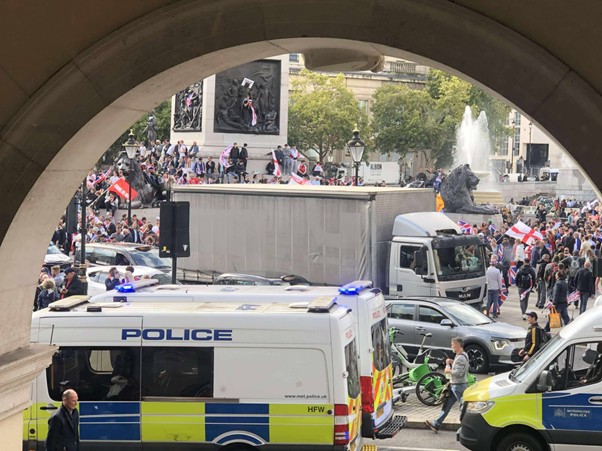
My view from Trafalgar Square’s Waterstones.
Riot police then entered the Waterstones café area for a tea. Some more came in after that to go to the bathroom.
[2PM]
Originally, I didn’t intend to go to Tommy Robinson’s Unite the Kingdom March, and yet my parents needed my help to collect some pictures in London. I dressed myself just in case the urge to attend overtook the urge to get lunch with them: I sorted my hair, got my fiery-red tartan scarf, and my very long Barbour jacket — “uniform”, I told my friend Herman. After getting the pictures and saying goodbye to mum and dad, I decided to get the Bakerloo Line from Piccadilly Circus, and then go to Embankment. I knew that a counter-protest was being organised and since I was late for the Tommy rally already, and didn’t want to get caught up by Antifa, I decided to take the train to Embankment and walk to Waterloo bridge, which I mistakenly believed was the real epicentre of the event. Disturbingly, as I stood waiting on the platform for the train, I saw two men, one at either end of the platform, wielding what in wrestling terms are known as “foreign objects”. One held a strange, sharp spherical glass object that looked like a damaged piece of lighting. His eyes were puzzled but had a certain violent determination flashing in them. The other was repeatedly smashing an umbrella against the floor. We eventually made eye contact. I was glad to remember when I boarded the train that the Underground carriages were separated rather than together, as in the case of the big, long Battle Royale mono-corridor that you find yourself presented with on the Elizabeth Line.
Emerging out of Embankment station, riot police had already sealed off one exit. They wore visors that obscured their faces as much as masks. They stood. They did not push. They effectively sat uninterrupted. This would go on to reflect the general police strategy seen throughout the day: keep calm and carry on. Someone on X used the phrase “urban scarecrow” to describe useless shopping centre security guards earlier this week. It was very much like that. The visors being up was a signal that violence was proximate and you should be careful not to interfere with them.
As I left the station, I wondered how much of the rally was left: chubby men courteously held out Union Jacks; I had half a mind to purchase one before realising that this would make me a target. I spoke with the salesman and removed my sunglasses — there were vague patriotic murmurs in the distance, but no cries of “Tommy!” until a good fifteen minutes later — and he told me that after they had crossed Waterloo Bridge the police had deliberately bisected the March. He said that it was “bullshit”. Later on I would pass under one half of Waterloo Bridge to see the other: there were at least a thousand people still passing over it, with at least one-in-three holding an English flag. The salesman wanted to know which platform I was reporting this for, and sighed with relief when I informed him that I was writing for Courage and did not want to damage or destroy his reputation.
I got up on the Waterloo Bridge myself because that’s where I imagined the plot of this particular historical event would unfold, and yet when I got halfway across my sight was drawn to another bridge. It was packed with white-shirted figures in the distance: I believe it was the Millennium Bridge. I thought that it was Antifa initially, but then I saw they also had English flags. Then all eyes, every eye on the bridge, every head, turned to the bank itself, the bank of embankment, where some twenty-five large police vans ploughed down the road, sirens blaring. I too made my way back over the bridge. I filmed myself uselessly with my laptop, my phone stupidly dying as I took an image of the police vans as they arrived.
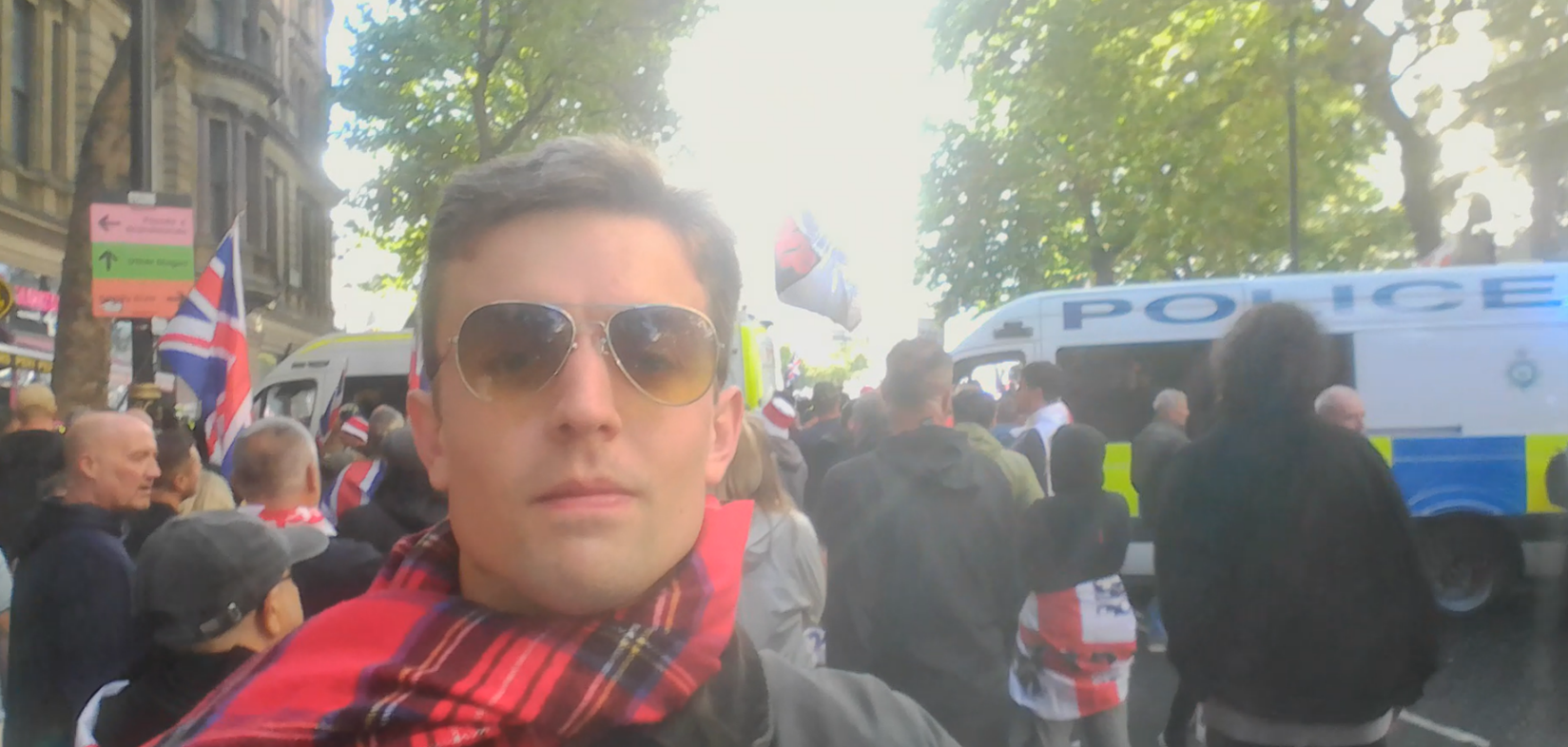
Photo taken with laptop near Embankment.
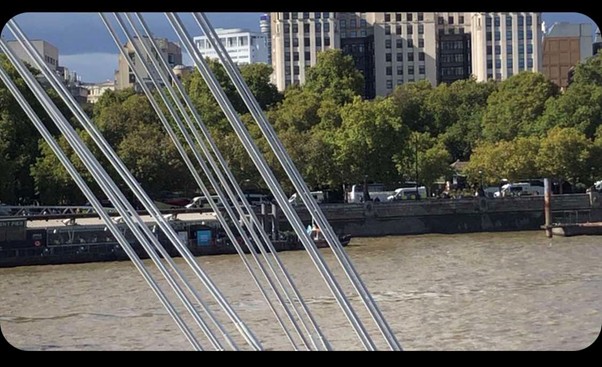
Police vans moving towards Embankment station.
[4PM]
From there, after shooting a video that showed the general scenery for a few friends, I felt I was in the veins of a living thing. Where the flags went, I followed. Joseph Conrad came to mind, his comments about the dark heart of a British colony itself pulsing, somehow, in the centre of London. First it was to Trafalgar, then to the Waterstones in order to charge my computer and my phone. Events already described passed. Then I stepped outside from Waterstones, into the havoc, into a strange world trying to be reborn. All about were beautiful, beautiful statues and people clambering with beer.
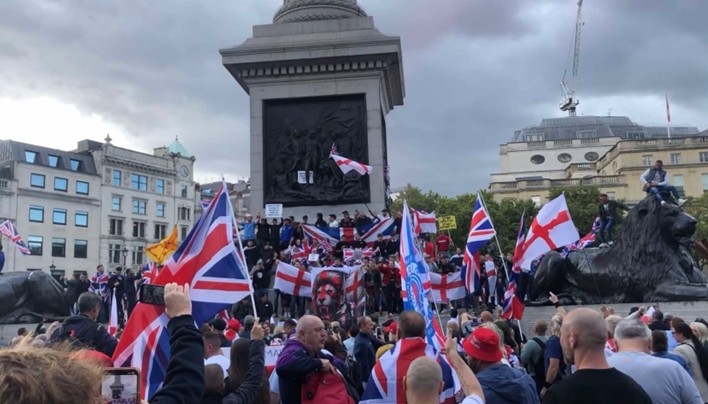
Nelson’s Column
When it came to Nelson’s Column, outfitted with St. George’s Crosses and Union Jacks and this time younger, more agile drunk men and women, it felt like looking at a scene from East Berlin when the Wall fell. Some of their cries were vulgar (“Keir Starmer’s a Wanker!” to the tune of “Seven Nation Army”, and “Oh, Tommy Tommy!”). But the tone changed when they began singing “Rule Britannia” in a hearty, although broken chorus. It was totally sincere. The men who had constructed that zone of monuments would not have liked their swearing, their bickering, everyone filming absolutely everything with camera phones. But they might have understood the impulse of the song. It was like looking at a student protest that sought to occupy this or that cultural zone to make an impact, and yet it was every age group, and it was unrelentingly real, not a hobby. When they joked, they joked with high seriousness.
Somehow a climber had managed to embed a plastic flag within the engraving at the centre of Nelson’s Column itself. But this wasn’t mere vandalism. It was not spraying “IS A RACIST” under Churchill’s statue’s name. It was an unlocking of the cultural potential of the engraving itself. Later I found the statue of a Victory goddess riding a chariot dedicated, I seem to remember, to a battle fought during the Crimean War. Behind her immaculate limbs, her charging, wild horses, some ordinary so-and-so had tied a St. George’s Cross. And it worked! The authenticity of the flag oddly complemented the statue, as did this one on the Column.
[4:30PM]
I then delved deeper into the crowd, the front. People wanted to go further, beyond Trafalgar. Thousands of red blood cells, as it were, pulsed in front of me, sang, vibrated with song, towards…yet more police officers, this time mounted on horses. I looked back: there were Antifa, the black flag flying. They were minuscule. I jumped to get a view of their faces: black sleeves over mouths, even a Covid mask or two. The subordination of that era had carried over into part of their identity.
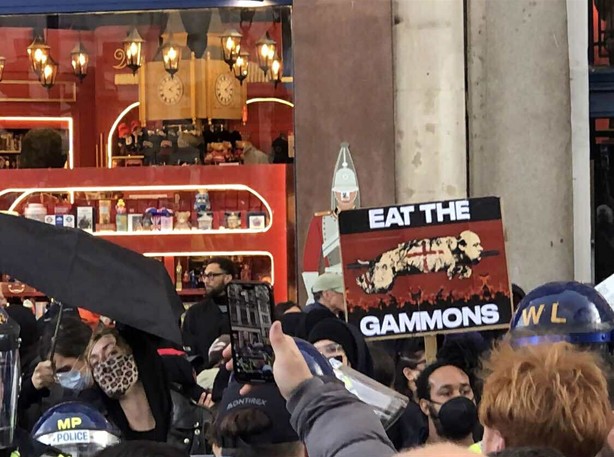
Antifa.
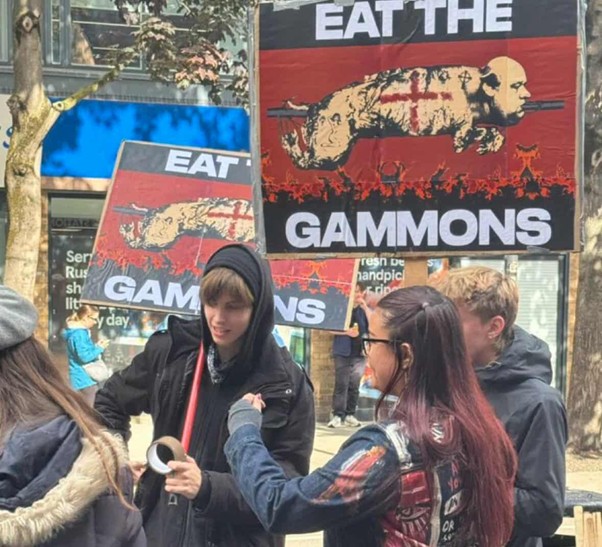
Shared with me later by a friend of mine: these signs were also professionally manufactured.
Previously, I had seen a miserable young man dance to grime as he displayed a painted board of wood with the words: “We are white, disposed, replaced” or something along those lines. I had also seen the aforementioned joy. But now I saw the knuckle dusters at the end of the long arm of the state. With Big Ben overseeing us down the bottom of the street, the police formed a military arrangement. I looked and saw that they were guarding Stand Up to Racism, a group already confirmed in Epping to have been bussed in by the police with video footage, and according to a man with a St. George’s Cross draped around him later that evening, “A Union Run” group; this also seems to be true. If the police were the knuckle dusters, they were the soft, flabby mitten of the state. Ideology and arms went together: SUR seemed organised in their own, however juvenile military formation behind their guards. A Roman general would have identified them as standard bearers.
SUR were arranged behind equestrian police officers — a column of at least ten huge stallions that might as well have been statues themselves. They raised their professionally manufactured, cardboard signs. You could not get a good look at them. Men shouted. Three times, I saw young chavvy boys bind up pieces of paper, cans, and God knows what else in yet more paper, and throw them as missiles into the crowd beyond. Only once did I see a missile land: into the cheek of a bearded, white policeman. The visors were donned shortly after that. I turned and noticed the police to my right side were also moving. I noticed a camera held not by an Antifa protestor, who had chanted something at me and I had laughed at, but by another policeman. It looked fairly peculiar, sophisticated, by no means a low-level DSLR, but facial recognition tech?
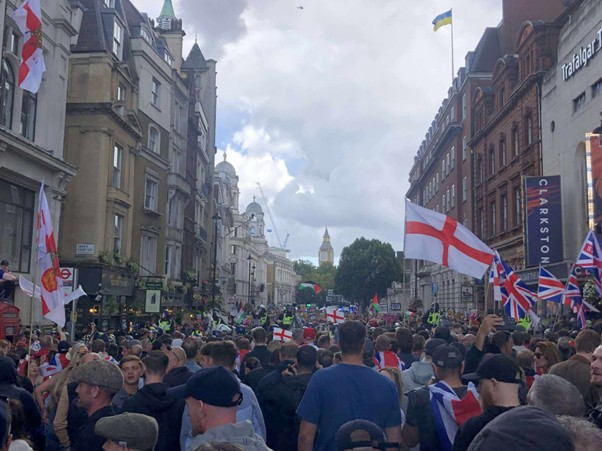
The crowd, followed by the line of equestrian police, followed by Stand Up to Racism (1).
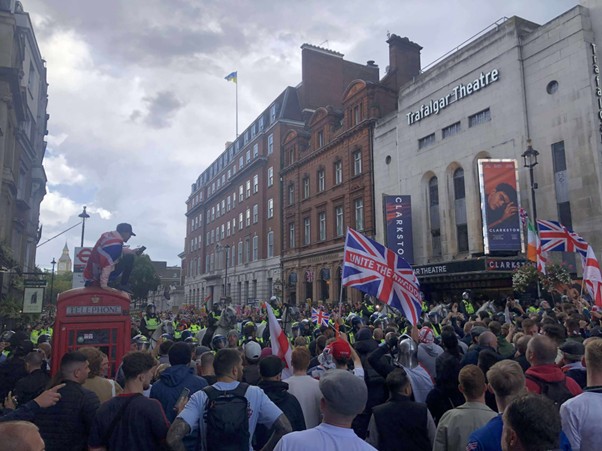
The crowd, followed by the line of equestrian police, followed by Stand Up to Racism (2).
At this point, partly from instinct, and partly from knowing a little about the nature of a military pincer movement, I knew the intention of the police was to segment the most forthright population of protestors and box them in. I wondered whether the horsemen, those living equestrian statues, were going to be allowed to stampede over them. I broke out of the area, out beyond Nelson’s Column as the men closed in. The Urban scarecrows suddenly formed an unbreakable line and nobody was allowed out. Perfectly normal, curious men spoke with them and said they had to get out and were thrown back in the only cases of violence, bar the throwing of missiles, I encountered over the course of the day. They were cornered. A pen: [later, at the restaurant I ate at, I smoked a cigarette and gratefully got a wine from a woman who had been caught in the nix; she told me they were stuck in there for at least two hours, and “The men were pissing everywhere!” Also, in the most amazing use of an England flag I have ever heard of, she apparently rolled up her trousers and urinated under it, using it as a shield, so no one would see.]
Leaving from Trafalgar, I bumped into an Englishman and woman as well as a Middle Eastern man with a French accent who I warned about potentially getting arrested if they returned that way. The English just wanted to talk about why they were angry, first at Stand Up to Racism, the “state asset”, before explaining that they were only at the protest to “save their kids”. They were terrified about Britain becoming an Islamic country, mentioned their daughters. They did not trust any member of the political class to protect them and feared taking matters into their own hands.
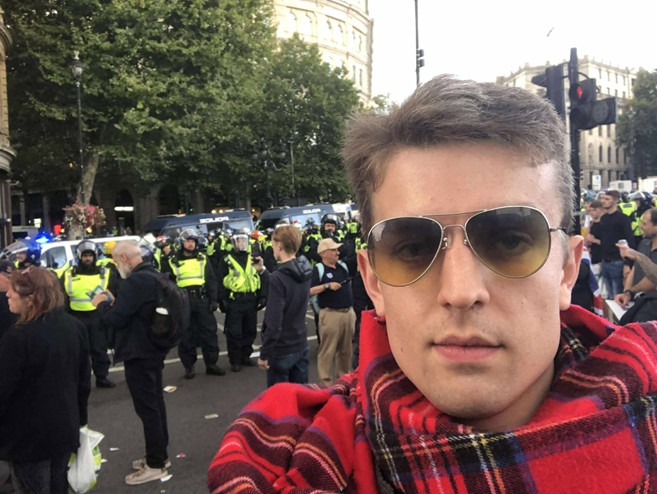
Riot police move in! (1)
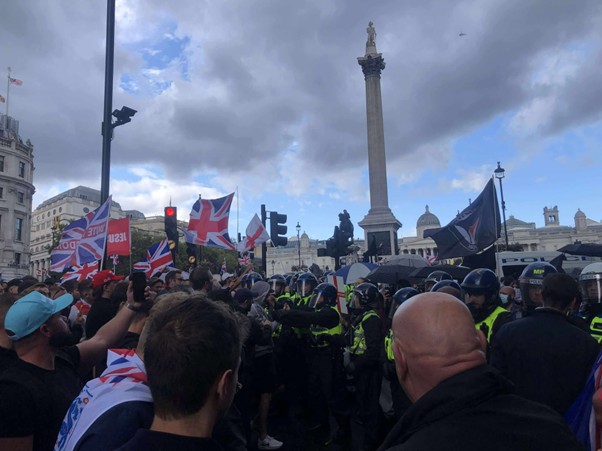
Riot police move in! (2)
The man with the nice French accent, meanwhile, admitted he was “far on the left side of things”, but acknowledged that “two million is a lot!” Nobody at the protest believed the numbers initially put out by the BBC, 110,000, or The Guardian, around 100,000, including this man on the left. The English couple said that it was the largest mass demonstration since the Iraq War protest in 2003. As ever, after wishing them goodbye, I followed the flags. Later that day, I bumped into a family on their way back from the Houses of Parliament, where I was now headed, and they told me that the police had initially been overwhelmed. They had apparently expected a million, and gotten “twice or three times more than that.” Hence the importance of breaking up the crowd into smaller, more manageable sections. My sense was that there were around 1 million people. Given I showed up late and there were still so overwhelmingly many, this sounds like a reasonable extrapolation.
Getting out of Trafalgar, I decided I would get to Big Ben, where yet more people seemed to be assembled. I passed down a street that I could use to avoid police blockades.
[?PM — lost track of time, eventually lost the charge on my devices]
The directions of the flagbearers around me were split. Some crowds surged one way. Some surged another way. As a result, I messaged my kind editor, who was in attendance, and he revealed that the real core of the protest was outside the Houses of Parliament, not Waterloo. So had I only been dealing with one segment of the March all along? How big was it really!? I followed where my badly charged phone took me, that and instinct. I saw statues dedicated to Gurkhas, overpowering iron faces with level eyes, great wings that spurted backwards like flows of blood. London had never struck me as a city of monuments before, and yet now after so many years of fearful absence after being threatened with a knife on the Elizabeth Line, I was back, and London was new, and the city was a playground. Here was a Martian race of iron. Even earlier that day, as I drove with my parents, Boudicca, or a statue I supposed was Boudicca, flung her arms from the top of a triumphal arch. It was between these figures we existed, we fleas. Everything else was tarmac, climbing frame, playground. I bounded down a set of stairs and found myself, turning on my left, at the Institute of Contemporary Arts. This was the ultra-liberal cinema and art gallery I used to frequent in my late teens. Here I had seen Gaspar Noe’s Climax (2018) when I was seventeen, the dance film where everyone drinks spiked hallucinogenic sangria, and goes crazy. Something was going on inside it that day. It was full. I worried slightly, although the concern was fading, about the Antifa mob. Would it be a wise idea to head into a bustling art student orgy whilst wearing a barber jacket and as bright and intimidating a scarf as I happened to be? I decided to approach some smokers outside after judging a sufficient number of them actually had nicotine. They were scrawny, upper-middle class, and well-spoken. They dressed in a way that can best be described as performatively skint.
Our discussion was short and amounted to me making a few excuses to hear about the nature of the ICA bookfair, which was the event going on in the building. Clearly, there was some intention to have it on during the same day as the Unite the Kingdom rally. The class difference in the attendees was abundantly obvious. When I mentioned that I had seen Antifa at the rally, one of the girls was excited, and ironically asked which universities they went to. I mentioned UCL and KCL as two options, but she largely dismissed this, suggesting that Antifa were probably out-of-work people. This didn’t seem to add up. The poster that I had seen Antifa wield, “EAT THE GAMMONS” was a deliberate expression of contempt for the white working-class, from a middle-class perspective of luxury progressive politics. The enemy was not the rich, the enemy was the poor, who they had already replaced in their minds with a more desperate, global proletariat. The modern university existed to foment that attitude. The cigarette the girl gave me quickly went out in my hand.
Initially, I was thinking of entering the bookfair, given the fact that the ICA shop stocks Stewart Home’s Smile and Cuboniks’s Xenofeminist Manifesto, both bizarrely interesting Far Left publications in their own right, before the subject turned to exactly why I was there, and everyone seemed to become so intrigued by my experiences at the “rally” — I was later told this was a troublesome word by an attendee, who “just wanted to defend her daughter” — that I didn’t really get to hear another opinion on the issue. There was resistance to the idea that Antifa and Stand Up to Racism were competing organisations. The young man on my left did not understand what I was speaking to them for, and after stamping out my roll, because I did not expect to be offered another lighter, I admitted I was a right-wing journalist who wanted to hear some left-wing views for a change, before beginning again on my journey to the Houses of Parliament. There was neither violence, nor scorn, but quiet intrigue, which I appreciated from the group. In case you read this: thank you for the cigarette, and hello.
As I walked through St. James’ Park, which was bizarrely empty, and beyond for about half a mile, I increasingly encountered many more large police vans, many more crowds of officers, here and there, potentially looking for me on the facial recognition camera? Here was the terror and joy of being, for once, alive. I was going into the middle of the world, the middle of the mind of the news media for that day, into the fears of the left and the dreams of the right. It was unavoidably exciting. My friend Herman awaited me in the middle of Londinium. There was a medievalism nascent and activated in the event. Peasant crowds burst. Where were the only 33% of Englishmen left in London? Here they were, and they were crying out.
Into my sight passed the flat, magisterial clockface of Pugin’s Big Ben. I remembered his dismissals of Protestants, my people, and looked over the river. Litter was everywhere. The bollards and steel barriers that Starmer’s government had summoned around the Houses of Parliament were also there. They did not want the rabble to permeate, to break in. Every minister, before the barbarian resistance of exactly those they claimed to represent, feared a second Cromwell, the barring of Blackrod ceremonially from the door. I passed further down on my left, deeper into crowds, amongst flags, into the playground of that metropolis, past more police. I entered a jeering section of the core crowd, the centre of the entire demonstration, and saw Advance UK’s Ben Habib speak about the necessity of ending “two-tier justice” on a gigantic glowing screen. The road tightened.
I walked deeper in. I was eye-deep. One screen was followed by another, then another. The crowd grew dense. It was very like feeling yourself the wandering protagonist of 28 Days Later (2002), the emptiness of an abandoned city giving way to an unassailable mass of bodies. What had happened? The ordinary existence of London had been suspended. War, almost, was on. And rubbish, unfortunately, was everywhere. The protestors had been rowdy, disrespected the architecture that surrounded them as an extension of despised Members of Parliament who lived and worked behind its elaborate walls and friezes.
But if, at the Reform conference I attended a week and a half before, I appreciated wise businessmen over drinks who had become councillors, men who had won everything available for the Boomer generation, great wealth, many grandchildren, and still wished to give to posterity by dispelling the influence of the left from local government, in this case — at the Unite the Kingdom March — I met the new citizenry of the new regime. They were tired, bitter. Men were too thin and too fat. There was nothing in between. And the women were angry, frightened. Perhaps over and above male anger, the emotion that really characterised the March was female terror, was women crying out for protection from a superior government.
All ate, all drank, all listened. The screens amplified the Advance UK message of Ben Habib to an audience who wished only to live in Great Britain. There were cries of “Tommy”, there were insults levied against Keir Starmer. Here was an army perfectly prepared to annihilate all the foes in their way and yet they played by the rules of political theatre. They danced and raved by beautiful sculptures built by greater men during better years. And nothing happened. The citizens revolt had come out and readied themselves and they were merely invited to appreciate a few speeches. Nothing happened. Nothing ever happens in populist politics.
I was reminded of the drunk man with the Union Jack riding one of the lions in Trafalgar Square. Here was the meat of England without leadership. It was the peasant stabbing his Lord’s foot with his scythe for failing to secure the feudal village from a foreign invasion. Was it righteous desecration? Even Thomas Hobbes talks about what happens when the protection-obedience clause of government is violated, and the lives of the dominated are spurned from safety: namely, chaos. On that count, the protestors felt that they had lost any reason to obey their superiors. Yet they had no leader of their own, no Watt Tyler, no Cromwell, no Prince Bonny Charlie. Tommy Robinson was just a Master of Revels, an actor, a fete-organiser, an entertainer. Perhaps if the men of the March were put under the command of the wise local councillors of Reform UK, and another group — perhaps Rupert Lowe’s Restore Britain — formed a Brahmin order, an elite group to control the entire structure from above, then a meaningful revolution could occur. Until then, the state need not worry.
As I thought about these possibilities, they began as if by magic to present themselves to me. I was there in the centre of the Parliament crowd for half an hour. Yet after a Polish man dressed as a priest with tear drops tattooed around his eyes chased out a sunglasses-wearing character for being “leftist scum”, and when I asked him why, he told me “taking photographs of everybody”, and after I had lost my own sunglasses in some incident, Elon Musk appeared. Robinson, or at least the holograph of Robinson on the big screen, finally brought up the man that “everyone should thank”. This was Elon.
From the beginning, the appearance of his gigantic face on the screen served its symbolic purpose. Zooming in from any one of his American properties, Elon appeared as the technocratic sovereign. Robinson was his court jester, beloved by the subjects of the new kingdom. Habib was there to gather an army for him, a rabble-rouser slash recruiting officer. Elon has long publicly endorsed Habib and his party Advance over Reform. Cynically then, the entire Unite the Kingdom March could be described as an event organised by X to promote Advance UK, which Elon supports and probably funds. This is despite the fact Habib’s hope to make his organisation an overnight success, as he directly said he wanted it to become, is unfortunately doomed due to his prior non-controversiality. Meanwhile, Farage is just too well-established by the media as regime enemy no.1 for Habib to compete. Elon’s speech was, however, significant.
It was predominantly dedicated not only to an accurate assessment of the demographic decline of the native English in London and Britain as a whole — “a slow cleanse”, as Elon claimed. But it was also organised to assert that the death of Charlie Kirk, a figure previously martyred by a Māori singing choir that day, represented a particular inflection point. Its central theme was that the left have gone insane. The left are violent. They are fundamentally opposed to normality and must be stopped. Elon summarised his opinion succinctly: “Violence is coming to you. You either fight or die.”
I increasingly believe this is what the right will do, and if the structure for an English revolt is not presently available, as more and greater members of the upper-middle class lose their incentives to buy into progressive politics, then we will get one in the next decade. All that is missing are the new elite and it is natural that they should emerge last. The body and the shoulders are there, and the head is gradually coming out. It’s a political breech birth. Consequently, many suppose that there is no head. And yet it will emerge.
In conclusion, the Unite the Kingdom March was clearly the beginning and not the end of something. Everyone I spoke to was hungry and desperate for change. Neither academia nor the state have any idea what they are dealing with. It would be wise for them to heed the concerns of the attendees whilst they still can.
Help Ensure our Survival

Comments (0)
Only supporting or founding members can comment on our articles.